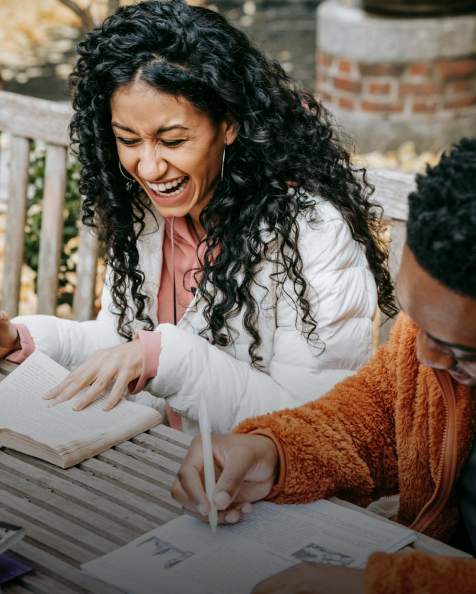Application Counseling:
- Getting To Know Student K:
- When Student K began working with us, her counselors wanted to learn more about her interests.
- She shared that she founded a youth advocacy journal and a research coalition with that focused on researching and acting on social injustice.
- Student K was also deeply involved with social justice and public policy through Model UN, Harvard Law School, and multiple scholarly journals.
- Student K had received national recognition for her policy and advocacy writing from entities like Stanford University, the United States Congress, and the Coca-Cola Foundation.
- Student K was also involved in her cultural community, teaching both traditional folk dance and language.
- Application Persona:
- Brainstorming: Based on her interests in policy and culture, Student K and her counselors brainstormed application personas that were both compelling and unique.
- Application Persona: We decided on the Application Persona of “Global justice advocate and community builder.” This persona would inform the rest of her application components and help us structure
her application in a focused and compelling way.
- School List Research:
- Creating the List: Now that we had a good idea of Student K’s strengths and weaknesses, and had developed her Application Persona, it was time to create a balanced school list.
- Organizing: We set up a spreadsheet that organized all schools on Student K’s list, categorizing them as Safety, Target, or Reach. This helped ensure that Student K’s school list was balanced.
- Early Round Strategy: From the beginning, Stanford was Student K’s top-choice school. We decided that it would be wisest to take advantage of Stanford’s Restrictive Early Action policy in order to convey that it was her first choice.
- Test-Optional Policies:
- Considerations: Student K’s scores were below the 25th percentile for Stanford. Her test scores didn’t reflect how strong her academic and extracurricular backgrounds actually were—and could potentially take focus away from her strengths.
- Strategy: Given that Stanford has maintained a test optional policy, we advised Student K her to apply without her test scores.
- Activities and Honors Sections:
- Planning: After deciding on Stanford, it was time to get started on the application itself. With so many high-level extracurriculars and honors, Student K’s Activities and Honors Lists were essential components to bring her Application Persona to life.
- Strategizing: Together with her counselors, Student K discussed which activities would convey a consistent theme while helping her stand out.
- Editing: We also provided high level feedback and line edits in order to demonstrate the work she had put into her various roles.
- Final Versions: Student K’s final activities and honor sections highlighted her leadership, ambition, and passion for international relations. They used tangible accomplishments and examples to promote her Application Persona of a global justice advocate & community builder.
- Letters of Recommendation:
- Strategizing: In order to further highlight Student K’s academic prowess, we helped her decide who would be the best fit to write her letters of recommendation. We guided her in writing cover letters to her teachers with talking points.
- Stanford Professor: Since Student K had taken an online course at Stanford, we thought it would be helpful if she had a recommendation from her professor, articulating how she would be a good fit for the college. We offered her feedback for her cover letter to the Stanford professor as well.
- Personal Statement: Schools like Stanford receive many more qualified applicants than they can accept, so Student K needed her personality and Application Persona to shine through in her essays.
- Brainstorming Topics: Student K’s counselor’s helped her brainstorm possible personal statement topics. Her Graduate Coach assigned a writing exercise to explore her topic options and determine which would suit Student K’s application packet best.
- Choosing a Topic: We encouraged her Student K to to explore her passion for dance and its intersecting themes with international relations in the first draft of her personal statement.
- Editing: Student K’s counselors challenged her to solidify the connections between these themes in her essay and gave her action items to complete before their next revision. Her counselors also offered high level comments and line-by-line feedback as the essay took shape.
- Final Version: The final version of Student K’s Personal Statement showcased her capacity for critical thinking and reflection, highlighted her leadership skills and passion for culture and politics, and displayed her excellent writing skills in a beautifully written essay.
- Supplemental Essays:
- Strategizing: Since Student K would not be submitting standardized test scores, she needed to emphasize school fit in her Supplemental Essays.
- Brainstorming: For each question, she brainstormed multiple short responses and her Former Admissions Officer helped her choose the best option for each question.
- Editing: Again, Student K’s counseling team guided her through multiple rounds of comments and detailed feedback to demonstrate her fit for Stanford.
- Final Version: In the final version of her short response answers, Student K was concise and intelligent, demonstrating her passion for justice and highlighting the reasons why she would be an excellent fit for the school’s community.
- Final Review: Once Student K’s application was ready after many rounds of edits, her Former Admissions Officer conducted a Final Review in which they analyzed Student K’s application as if she were still in the admissions office. After the FAO’s feedback on word choice, formatting, and more, Student K got the go-ahead to submit!

